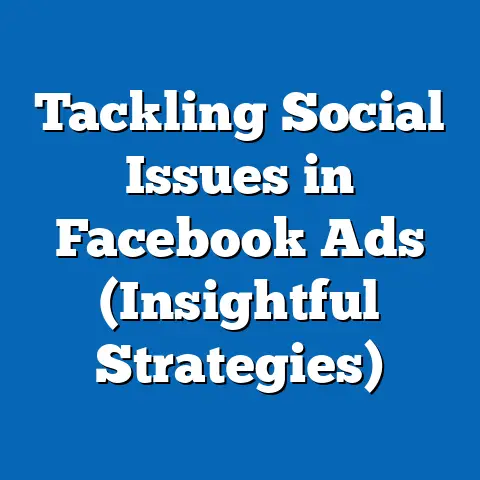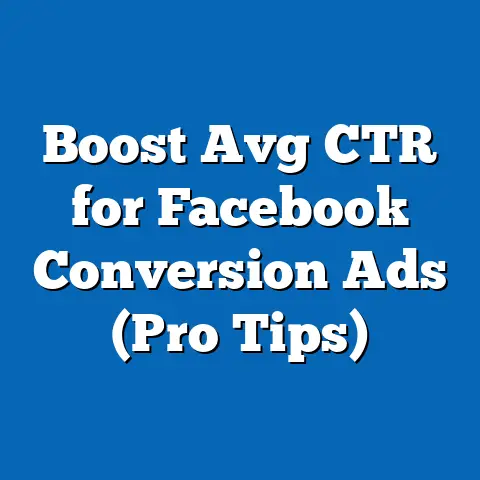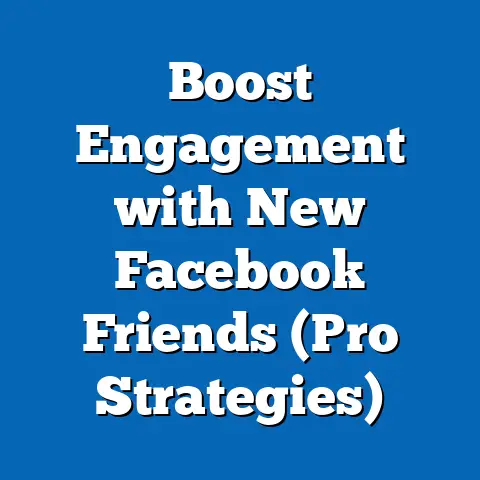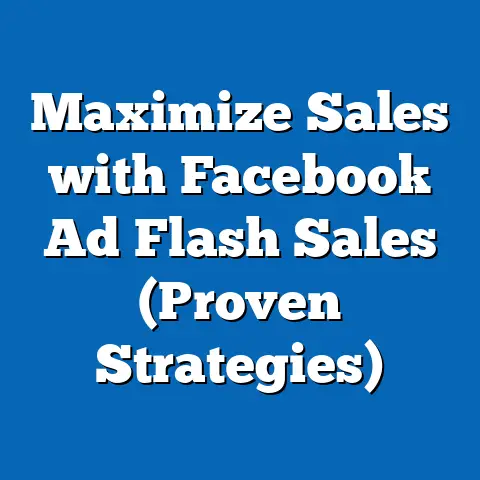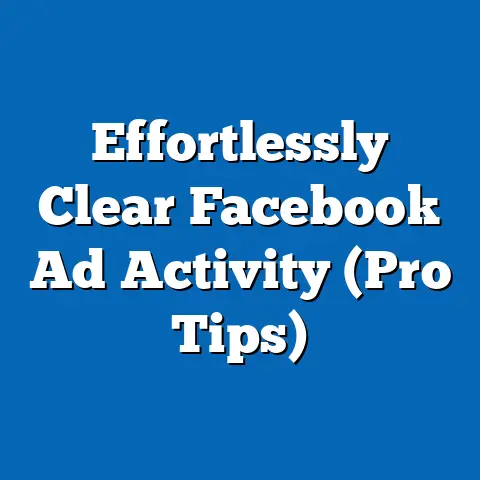Effective Lead Collection with Facebook Ads (Expert Strategies)
In today’s digital landscape, where consumers spend a significant portion of their time online, businesses are increasingly turning to social media platforms for lead generation. Among these platforms, Facebook stands out as a powerhouse, boasting billions of active users. According to Statista, as of 2023, Facebook has nearly 3 billion monthly active users, making it a fertile ground for marketers looking to connect with potential customers.
I’ve personally witnessed this transformation firsthand. Back in 2015, when I was starting my own digital marketing agency, Facebook was just beginning to be recognized as a serious advertising platform. I remember spending hours experimenting with different ad formats, targeting options, and creative approaches. It was a steep learning curve, but the results were undeniable. We were able to generate high-quality leads at a fraction of the cost of traditional advertising methods.
Section 1: Understanding Facebook Ads for Lead Generation
Before diving into the specifics of lead collection, it’s essential to have a solid understanding of Facebook ads and how they function.
What are Facebook Ads?
Facebook ads are paid advertisements that appear on the Facebook platform. They can take various forms, including images, videos, carousels, and lead ads, and are designed to capture the attention of users as they browse their newsfeeds, watch videos, or engage with content.
Why are Facebook Ads Effective for Lead Generation?
- Reach: Facebook’s massive user base provides unparalleled reach, allowing businesses to connect with potential customers across the globe.
- Targeting: Facebook’s sophisticated targeting options enable businesses to reach specific demographics, interests, behaviors, and even custom audiences based on their own customer data.
- Engagement: Facebook ads can be highly engaging, capturing the attention of users and encouraging them to interact with your brand.
- Measurability: Facebook’s advertising platform provides detailed analytics, allowing businesses to track the performance of their ads and optimize their campaigns for maximum ROI.
Ad Formats for Lead Collection:
- Image Ads: Simple yet effective, image ads can be used to showcase your product or service and drive traffic to your website or landing page.
- Video Ads: Video ads are highly engaging and can be used to tell a compelling story, demonstrate your product, or provide valuable information to your audience.
- Carousel Ads: Carousel ads allow you to showcase multiple images or videos in a single ad, making them ideal for showcasing a range of products or services.
- Lead Ads: Lead ads are specifically designed for lead collection, allowing users to submit their contact information directly within the Facebook platform.
Targeting Options on Facebook:
- Demographics: Target users based on age, gender, location, education, and other demographic factors.
- Interests: Target users based on their interests, hobbies, and passions.
- Behaviors: Target users based on their online behaviors, such as purchase history, website visits, and app usage.
- Custom Audiences: Create custom audiences based on your own customer data, such as email lists, website traffic, and app users.
Takeaway: Facebook ads offer a powerful and versatile platform for lead generation. By understanding the different ad formats and targeting options available, you can create highly effective campaigns that reach your ideal customers and drive conversions.
Section 2: Crafting Compelling Ad Copy and Creative
The success of your Facebook ad campaigns hinges on the quality of your ad copy and creative. Your ads need to capture the attention of users, resonate with their needs and interests, and compel them to take action.
The Importance of Engaging Ad Copy:
- Grab Attention: Your ad copy needs to stand out from the clutter and grab the attention of users as they scroll through their newsfeeds.
- Resonate with Your Audience: Your ad copy should speak directly to the needs and interests of your target audience, addressing their pain points and offering solutions.
- Clearly Communicate Your Value Proposition: Your ad copy should clearly communicate the value you offer to potential customers, highlighting the benefits of your product or service.
- Include a Call-to-Action: Your ad copy should include a clear and compelling call-to-action (CTA) that encourages users to take the next step in the lead collection process.
Tips for Writing Compelling Headlines and Descriptions:
- Use Strong Verbs: Start your headlines and descriptions with strong verbs that convey action and excitement.
- Highlight Benefits: Focus on the benefits of your product or service, rather than just the features.
- Ask Questions: Engage your audience by asking questions that pique their curiosity and encourage them to learn more.
- Create a Sense of Urgency: Use language that creates a sense of urgency, encouraging users to take action now.
- Keep it Concise: Keep your headlines and descriptions short and to the point, focusing on the most important information.
The Role of Visuals in Ad Performance:
- Capture Attention: Visuals are the first thing users see when they encounter your ad, so they need to be eye-catching and visually appealing.
- Evoke Emotion: Visuals can evoke emotion and create a connection with your audience, making your ad more memorable and impactful.
- Showcase Your Product or Service: Visuals can be used to showcase your product or service in action, demonstrating its value and benefits.
- Maintain Brand Consistency: Your visuals should be consistent with your brand’s overall aesthetic, reinforcing your brand identity and building trust with your audience.
Tips for Selecting Images or Videos:
- Use High-Quality Images: Use high-resolution images that are clear, crisp, and visually appealing.
- Choose Relevant Visuals: Select images or videos that are relevant to your ad copy and your target audience.
- Test Different Visuals: A/B test different visuals to see which ones perform best with your audience.
- Use Video to Tell a Story: Use video to tell a compelling story, demonstrate your product, or provide valuable information to your audience.
Incorporating a Clear Call-to-Action (CTA):
- Make it Prominent: Your CTA should be prominent and easy to find, so users know exactly what you want them to do.
- Use Action-Oriented Language: Use action-oriented language that encourages users to take the next step, such as “Learn More,” “Sign Up Now,” or “Get Your Free Trial.”
- Match Your CTA to Your Offer: Your CTA should be relevant to your offer and the overall goal of your campaign.
- Test Different CTAs: A/B test different CTAs to see which ones perform best with your audience.
Takeaway: Crafting compelling ad copy and creative is essential for capturing the attention of your target audience and driving conversions. By following these tips, you can create ads that resonate with your audience, communicate your value proposition, and encourage users to take the next step in the lead collection process.
Section 3: Utilizing Lead Ads for Direct Lead Collection
Facebook Lead Ads offer a streamlined and efficient way to collect leads directly within the Facebook platform. These ads allow users to submit their contact information without ever leaving Facebook, making the process quick, easy, and convenient.
What are Facebook Lead Ads?
Facebook Lead Ads are a type of ad format specifically designed for lead collection. When a user clicks on a Lead Ad, they are presented with a pre-populated form containing their contact information, such as their name, email address, and phone number. Users can then review and submit the form with just a few taps, making the process incredibly simple and user-friendly.
How do Lead Ads Work?
- User Sees Ad: A user sees your Lead Ad in their Facebook newsfeed.
- User Clicks Ad: The user clicks on the ad to learn more about your offer.
- Lead Form Opens: A pre-populated lead form opens within the Facebook platform.
- User Submits Form: The user reviews their information and submits the form with just a few taps.
- You Receive Lead: You receive the user’s contact information and can follow up with them directly.
Setting Up a Lead Ad Campaign:
- Choose Your Objective: When creating your campaign, select the “Lead Generation” objective.
- Define Your Audience: Define your target audience based on demographics, interests, behaviors, and custom audiences.
- Create Your Ad: Choose an ad format (image, video, or carousel) and craft compelling ad copy and creative.
- Design Your Lead Form: Design your lead form, selecting the information you want to collect from users.
- Set Your Budget and Schedule: Set your budget and schedule for your campaign.
- Review and Publish: Review your campaign settings and publish your ad.
Best Practices for Creating Effective Lead Forms:
- Use Pre-Filled Information: Pre-fill the lead form with information that Facebook already knows about the user, such as their name, email address, and phone number. This makes the process quicker and easier for users.
- Ask Relevant Questions: Ask only the questions that are essential for qualifying your leads.
- Keep it Short and Simple: Keep your lead form short and simple, minimizing the amount of time and effort required from users.
- Optimize for Mobile Devices: Ensure that your lead form is optimized for mobile devices, as most Facebook users access the platform on their smartphones.
- Provide a Clear Privacy Policy: Include a clear and concise privacy policy that explains how you will use the user’s contact information.
- Offer an Incentive: Offer an incentive for users to submit their contact information, such as a free ebook, a discount code, or a consultation.
Takeaway: Facebook Lead Ads offer a powerful and convenient way to collect leads directly within the Facebook platform. By following these best practices, you can create effective lead forms that capture high-quality leads and drive conversions.
Section 4: Building Targeted Audiences for Effective Lead Generation
One of the key advantages of Facebook advertising is its ability to target specific audiences based on a wide range of factors. By building targeted audiences, you can ensure that your ads are seen by the people who are most likely to be interested in your product or service.
The Importance of Audience Segmentation:
- Reach the Right People: Audience segmentation allows you to reach the people who are most likely to be interested in your product or service.
- Improve Ad Relevance: By targeting specific audiences, you can create ads that are more relevant to their needs and interests.
- Increase Conversion Rates: Reaching the right people with relevant ads will increase your conversion rates and drive more leads.
- Reduce Ad Spend: By targeting specific audiences, you can reduce your ad spend and get more bang for your buck.
Creating Custom Audiences:
- Website Traffic: Create a custom audience based on people who have visited your website. This allows you to retarget users who have already shown an interest in your brand.
- Engagement with Previous Ads: Create a custom audience based on people who have engaged with your previous ads, such as liking, commenting, or sharing.
- Customer Lists: Upload your customer email list to Facebook to create a custom audience of your existing customers. This allows you to target your existing customers with special offers or promotions.
Exploring Lookalike Audiences:
- Expand Your Reach: Lookalike audiences allow you to expand your reach by targeting people who are similar to your existing customers or website visitors.
- Find New Leads: Lookalike audiences can help you find new leads who are likely to be interested in your product or service.
- Improve Campaign Performance: By targeting lookalike audiences, you can improve the performance of your ad campaigns and drive more conversions.
Takeaway: Building targeted audiences is essential for effective lead generation on Facebook. By segmenting your audience based on demographics, interests, behaviors, and custom audiences, you can ensure that your ads are seen by the people who are most likely to be interested in your product or service.
Section 5: Leveraging Retargeting Strategies
Retargeting is a powerful strategy for re-engaging users who have interacted with your brand but have not yet converted into leads. By showing ads to people who have visited your website, watched your videos, or engaged with your previous ads, you can remind them of your offer and encourage them to take the next step.
The Significance of Retargeting in Lead Collection:
- Re-Engage Interested Users: Retargeting allows you to re-engage users who have already shown an interest in your brand.
- Increase Brand Awareness: Retargeting helps to increase brand awareness by keeping your brand top-of-mind for potential customers.
- Drive Conversions: Retargeting can drive conversions by reminding users of your offer and encouraging them to take the next step.
- Personalized Messaging: Retargeting allows you to deliver personalized messages to users based on their previous interactions with your brand.
Setting Up Retargeting Campaigns:
- Create a Custom Audience: Create a custom audience based on people who have visited your website, watched your videos, or engaged with your previous ads.
- Choose Your Objective: When creating your campaign, select the “Conversions” or “Lead Generation” objective.
- Target Your Custom Audience: Target your custom audience with your retargeting ads.
- Craft Compelling Ad Copy and Creative: Craft compelling ad copy and creative that reminds users of your offer and encourages them to take the next step.
- Set Your Budget and Schedule: Set your budget and schedule for your campaign.
- Review and Publish: Review your campaign settings and publish your ad.
Examples of Effective Retargeting Ad Strategies:
- Dynamic Ads: Dynamic ads allow you to show users the specific products or services they viewed on your website. This is a highly effective way to re-engage users and encourage them to make a purchase.
- Sequential Messaging: Sequential messaging allows you to deliver a series of ads to users over time, each with a different message. This is a great way to build brand awareness and guide users through the sales funnel.
- Offer a Discount or Promotion: Offer a discount or promotion to users who have visited your website but have not yet converted. This can be a great way to incentivize them to take the next step.
Takeaway: Retargeting is a powerful strategy for re-engaging users who have interacted with your brand but have not yet converted into leads. By setting up retargeting campaigns, you can remind users of your offer and encourage them to take the next step.
Section 6: Analyzing and Optimizing Campaign Performance
Tracking and analyzing your campaign performance is essential for optimizing your Facebook ad campaigns and maximizing your lead generation results. By monitoring key metrics and making data-driven decisions, you can improve your ad performance and drive more conversions.
The Importance of Tracking and Analyzing Ad Performance:
- Identify What’s Working: Tracking and analyzing your ad performance allows you to identify what’s working and what’s not.
- Optimize Your Campaigns: By monitoring key metrics, you can optimize your campaigns for maximum ROI.
- Improve Conversion Rates: Optimizing your campaigns will improve your conversion rates and drive more leads.
- Reduce Ad Spend: By identifying what’s not working, you can reduce your ad spend and get more bang for your buck.
Key Metrics to Monitor:
- Click-Through Rate (CTR): The percentage of users who click on your ad after seeing it.
- Conversion Rate: The percentage of users who convert into leads after clicking on your ad.
- Cost Per Lead (CPL): The cost of acquiring one lead through your Facebook ad campaigns.
- Reach: The number of unique users who saw your ad.
- Frequency: The average number of times each user saw your ad.
Strategies for A/B Testing:
- Ad Copy: Test different headlines, descriptions, and CTAs to see which ones perform best with your audience.
- Creative: Test different images and videos to see which ones are most eye-catching and engaging.
- Targeting: Test different targeting options to see which audiences are most likely to convert.
- Placement: Test different ad placements to see which ones generate the best results.
Takeaway: Analyzing and optimizing your campaign performance is essential for maximizing your lead generation results on Facebook. By monitoring key metrics and A/B testing different ad elements, you can improve your ad performance and drive more conversions.
Conclusion
Facebook ads offer a powerful and versatile platform for effective lead collection. By understanding the platform’s advertising capabilities, crafting compelling ad copy and creative, building targeted audiences, leveraging retargeting strategies, and analyzing campaign performance, you can create highly effective campaigns that reach your ideal customers and drive conversions.
Remember, the world of Facebook advertising is constantly evolving. New features, targeting options, and ad formats are being introduced all the time. It’s essential to stay updated with the latest trends and best practices to ensure that your campaigns remain effective.
I encourage you to implement these strategies in your own Facebook ad campaigns and experiment with different approaches to see what works best for your business. Don’t be afraid to try new things and push the boundaries of what’s possible.
Call to Action
Now it’s your turn! Take the tips and strategies I’ve shared in this guide and start experimenting with your own Facebook ad campaigns. I’m confident that by implementing these expert strategies, you can significantly enhance your lead generation efforts and drive more business growth.
I’d love to hear about your experiences and results. Share your thoughts, questions, and successes in the comments below or on social media. Let’s learn from each other and build a community of successful Facebook advertisers!

